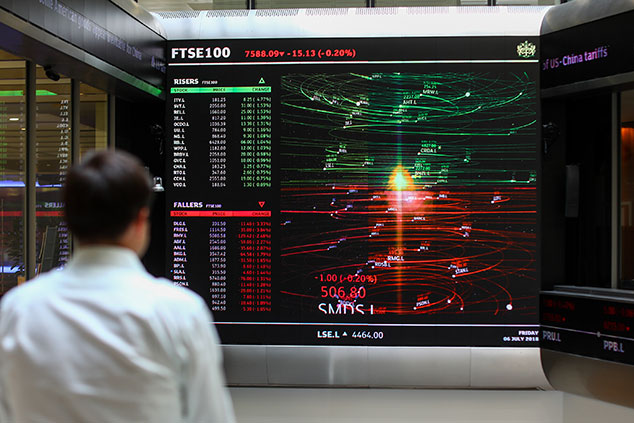
This article is taken from our FREE daily investment email Money Morning.
Every day, MoneyWeek’s executive editor John Stepek and guest contributors explain how current economic and political developments are affecting the markets and your wealth, and give you pointers on how you can profit.
In this week’s issue of MoneyWeek magazine
●
The British software sector stars investors should buy now
●
The ultimate contrarian signal?
●
P2P car loans for subprime borrowers
●
Three stocks that are ripe with opportunity
●
Two funds to profit from Asia’s love for smartphones
● Share tips of the week
Not a subscriber? Sign up here
Wall Street had another mediocre day yesterday.
Last week, the S&P 500 fell by more than 4%. No big deal in the annals of stockmarket history, but a pretty chunky decline compared to what most investors have grown used to in recent years.
Still – the sense of panic has calmed a little. Are we close to the end of this particular squall?
The tone of the market has changed
I keep an eye on a lot of different market commentators. Over the years of trawling through the media, analysis services, and endless research reports, you do get a feel for who’s good at what.
Some outlets just parrot whatever the narrative of the day happens to be. Beyond staying aware of what’s “in the price”, you don’t need to pay much attention to that stuff.
But some commentary is high quality. No one can predict the future, but some writers have a much better “market sense” than others. And I have to say that some of the best of these are technical analysts (or chartists).
Now you might think that technical analysis is a load of rubbish. Drawing a load of graffiti on a chart, then trying to spot repeating patterns? Might as well sift through a chicken’s entrails.
I’m not going to ask you to suspend your disbelief. What I will say is that experienced traders are looking at the market every day. Technical analysis is the only possible way to look at the market on that sort of time frame. Fundamentals give you no clue as to how the market might move on a day to day or hour to hour basis.
So if you want to succeed at trading (and to be clear, most people don’t succeed, because it’s almost impossible to control your emotions in that environment, even if you have what looks like a good system in place), then you have to have a clear-eyed view, backed up by evidence, of what you think the overall market “tone” is at any point in time.
And what strikes me is that, for this particular group, the tone has changed. Reading their commentaries, the market observers with some of the better records – ones who are neither permabears nor permabulls – are cautious right now. These same people were relaxed during the 2015 crash, for example.
You do have to take all of these things with a pinch of salt. No one can predict the future. It doesn’t necessarily mean this is “the big one”. Good traders are flexible. They might be bearish today, but if their technical indicators point upwards tomorrow, then they’ll change their minds.
But smarter traders now seem to be in “sell the rip” rather than “buy the dip” mode (they do love their catchy slogans). And that’s new.
A relatively inexpensive market close to home
As for the fundamentals – well, I probably don’t need to tell you that those look tricky.
Put aside the politics for now. Politics is always fraught with tripwires. The real issue – as we’ve been saying for a while – is rising borrowing costs.
Monetary policy is steadily tightening across the globe. In theory, this shouldn’t matter because the economy is stronger than it was. In practice, this ignores the fact that investors and the global economy have been moulded over the past decade by our near-zero interest rate environment.
There are things that make sense at 0% interest rates that no longer make sense once interest rates start to go up. That’s true regardless of how strong or otherwise the underlying economy is.
That implies – at minimum – a period of transition as things that no longer make sense have to adjust. For example, things that may no longer make sense at higher interest rates include the whole process of using debt to retire equity. If companies no longer see the value in issuing debt at low interest rates to do share buybacks, then that will hit demand for equities.
That might not have to be a disaster. But it does imply that highly-valued markets will struggle more than those which are more modestly valued.
Conveniently, one of the less risky-looking markets right now on that front is the UK. We’ve been widely detested for some time now, due to the political noise over Brexit. But in turn that means that we look less vulnerable to a general loss of confidence because sentiment towards the UK is already pretty glum.
We are often at pains to remind you not to fall prey to home market bias (the tendency of investors to keep too much money in their domestic market relative to its importance in the global economy). And clearly you should still have plenty of overseas market exposure.
But this is one of those periods where considering being a little bit “overweight” the UK in your portfolio probably isn’t such a bad thing.
Oh and I’ll be writing a lot more about the current market correction, what’s driving it, and what the longer term holds in the next issue of MoneyWeek magazine, out on Friday. Subscribe now if you haven’t already.